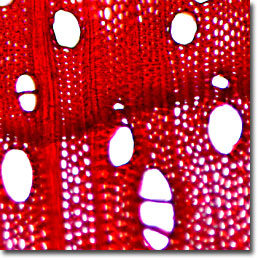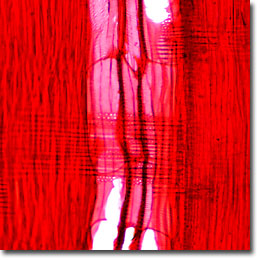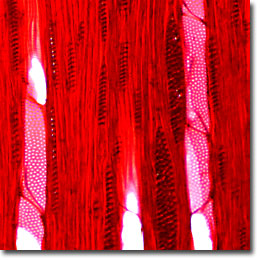The Sugar Maple
The Sugar Maple (Acer saccharum; also known as the Hard Maple) is a hardwood tree inhabiting Canada and the United States from Newfoundland to South Dakota and south to Texas and Georgia. The sapwood is white with a reddish tinge, while the heartwood is a uniform light reddish brown in color.

Cross Section

Radial Section

Tangential Section
Like many other species in the Aceraceae family, the sugar maple is a tall tree and many specimens reach a height of almost 100 feet. The leaves contain three to five lobes and resemble those of the Norway maple, being almost six inches wide and turning red, scarlet, orange, or yellow in the fall. Flowers of the sugar maple are light yellow in color and droop in clusters before the leaves unfold.
Although the sugar maple is a very slow-growing tree, it is an outstanding ornamental and sparkles in the fall with a dazzling display of color and hue. The tree requires better soil conditions, moist but not soggy and well drained, than other members of the genus. Sugar maples are quite well known for their sap, which yields maple syrup and sugar.
Sugar maple and black maple wood is often sold indiscriminately as hard maple, which can be distinguished from the soft maples through examination of the rays. Hard maple wood is sometimes confused with dogwood. Among the many uses of sugar maple wood are charcoal production, railroad ties, veneer, plywood, bowling pins, furniture, boxes, crates, pallets, mill products, sporting and athletic goods, musical instruments, and butcher's blocks.
Microscopic examination of iron-alum hematoxylin and safranin stained thin sections (see the digital images presented above) reveals a diffuse and porous wood with simple perforation plates. The parenchyma is sparse and vessels are few to moderately numerous. Inter-vessel pits are 6 to 10 micrometers in diameter and orbicular or angular in shape. Fibers libriform and fiber tracheids are thin to moderately thick-walled and fine to coarse in texture. The rays are unstoried, essentially homocellular, and 3 to 8 seriate.